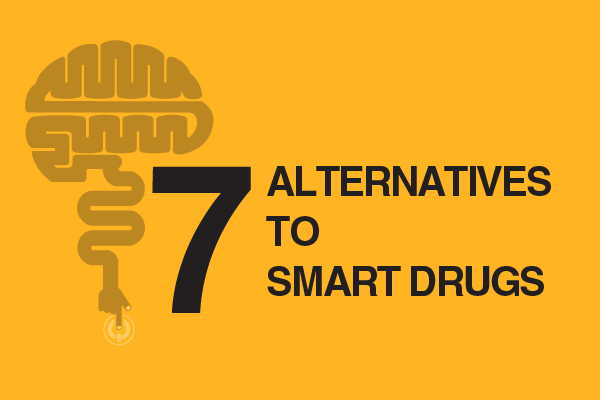Whether in the news, online, or in popular media, we have probably all heard of ways of enhancing our cognitive abilities through nootropics, also called “smart drugs”. But there has been some controversy concerning the moral, ethical, and health implications of their use.
As research advances, new smart drugs are discovered or created in labs. Their use does not show any signs of slowing. But with research come advancements in the alternatives to smart drugs. Many people are turning to these alternatives to replace or to enhance the benefits of drugs. But are they any less morally and ethically ambiguous? Are they any safer? Are they better for productivity?
We will look at seven alternatives to smart drugs and see what the research tells us.
Pathways to cognitive enhancement
1. Brain stimulation
This may sound like the stuff of science fiction, but many people are trying to improve cognitive functioning through electrical currents and lasers directed toward their brains.
Transcranial direct current stimulation (tDCS) used electrodes placed on the scalp to pass a low electrical current through the brain. Various studies have shown that tDCS can improve accuracy, performance, learning, and working memory. Researchers need to do more research on the long-term effects of this treatment and more specifics about how to make the treatment work accurately, but beginning research shows that it has potential to increase cognitive functioning.
In transcranial laser stimulation, also called low-level light therapy, pulses of light provided by lasers or LEDs are directed at the entire head or a specific part of the skull. The theory behind this intervention is that light in the red and near-infrared regions of the spectrum can pass through the skull and brain. The energy from the lights activates cells and creates growth and repair functions in the brain. Studies have shown that laser or light stimulation can increase attention, accuracy, and memory.
2. Neurofeedback
Using real-time feedback about brain activity, neurofeedback can help people focus on certain tasks in order to achieve higher activity levels in certain areas of the brain. Various studies have shown that neurofeedback provides enhancements in perception, motor skills, and memory.
Neurofeedback has turned into a growing business as companies use it to reach “peak performance.” Olympic athletes, NASA astronauts, US soldiers, musicians, poker players, surgeons, business executives, and many more groups of people have all used neurofeedback to target certain areas of the brain.
3. Hyperbaric oxygen
Hyperbaric oxygen requires that a person lay down in a sealed chamber while they breathe in pressurized air containing 100% oxygen. While there are few studies available, one study showed that hyperbaric oxygen increased memory and cognitive performance.
Curious to know how you can improve employee engagement using neuroscience? Download our free eBook on Neuroscience in the Workplace!
4. Video games
You have probably seen the ads for apps about brain training games on a computer, tablet, or phone. They claim to help you improve your cognitive skills and fight off mental declines as you age. Many people have believed these claims.
Research shows that many of the claims may be too good to be true. In studies comparing games to various controls, researchers found that there were some improvements, but they were very small. They also found no evidence that these slight improvements translate into real world settings.
But all is not lost in the world of gaming. Research into action video games has shown greater results. While action games and the violence they usually display are not without controversy, some of the elements of the games seem to support cognitive functioning. Findings from the University of Wisconsin have shown that action video games can improve perceptual skills, selective attention, and cognitive flexibility. These types of games can set up the brain for learning new tasks more easily. The important qualities of these games are their variety and need for attentional flexibility.
Companies like Google and Facebook have provided video games to employees for years. Many smaller companies are following this trend as the games can increase productivity.
It seems that not all games are created equal. If you decide to go this route, you might not want to expect the results and know that you may not be getting all that you paid for.
5. Fasting
At the nootropics company, Nootrobox, employees do not eat on Tuesdays. They go without eating for 36 hours because they feel it helps improve their focus and concentration. Other people skip breakfast and lunch, only eating dinner every day.
The theory behind fasting is the benefits of ketosis. The body goes into a state of ketosis when there is not enough energy provided by food intake and the body starts to burn fat for energy. That process could potentially help them focus and stay alert.
It seems they may be on to something. Research does show that not only can caloric restriction increase your lifespan and improve your immune system, but fast can actually improve cognitive functioning, reduce inflammation, and decreases the effects of stress.
6. Exercise
We have all probably thought or heard from someone else that we should exercise more. It makes us healthier. We lose weight and gain muscle. But it can also help our cognitive performance. Exercise increases blood flow to the brain, alters neurotransmitter release, and increases the rate of structural changes in the brain and central nervous system.
In a study of female college students, researchers found that exercise activates certain parts of the brain related to executive functioning and memory. A study from 2016 specifies that aerobic exercises are the most effective at creating positive changes in the brain and cognitive performance.
These results can even be applied to business. Employees who use their lunch breaks to exercise for 30-60 minutes were 15% more productive when they returned to work. Those employees stated that they managed time better, performed tasks more effectively, and felt better when they exercised.
7. Mindfulness and meditation
Mindfulness, the act of staying in the present moment, shows a lot of promise according to the increasing amount of research done on the topic. Research show that mindfulness and meditation can improve executive functioning and reduce stress.
Whether you believe it is a trend or proven practice, many companies are jumping to mindfulness to produce better results. Google, Aetna, Apple, and Deutsche Bank are just a few of the companies offering mindfulness and meditation.
Aetna has provided results of their efforts when after the first year of a mindfulness program they saw health care costs decrease. They were able to save money by introducing mindfulness. They also were able to make more money. They calculated that through mindfulness employees gained 62 minutes of productivity, equaling about $3,000 per year, per employee.
It seems that any of those seven practices would be good for productivity. And it looks like many businesses have already started using them and have seen great results.
As for the questions we started with, many of these practices have positive health benefits, in addition to cognitive benefits. Similar to some of the “smart drugs”, there has not been a great deal of research about the short term and long term effects of some of these interventions. We cannot offer medical advice, but it does not seem like anyone would argue with adding a bit more exercise and mindfulness into our lives, though.
All these practices have the potential to be better or just as good for productivity as “smart drugs” are, but there is more research that needs to be done to make direct comparisons. As for the moral implications, it seems safe to say that some of these practices are more socially acceptable than others. Does that make them more moral? Maybe it comes down to intention and how far companies or employees are willing to go to get ahead. Maybe the best place to start is being open with ourselves and our employees about our goals and what we want to do to achieve them.
Download the eBook and learn how to use neuroscience to attract the right talent, retain high-performing employees and foster collaborative teams.
Image vector licensed from Depositphotos.com






Leave A Comment